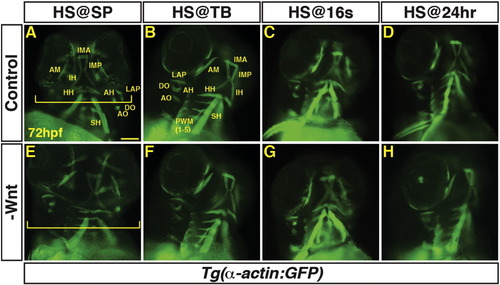Fig. 3
- ID
- ZDB-FIG-170413-16
- Publication
- Mandal et al., 2017 - Wnt signaling balances specification of the cardiac and pharyngeal muscle fields
- Other Figures
- All Figure Page
- Back to All Figure Page
|
Decreased Wnt signaling during gastrulation increases head size with minimal effect on PM morphology. (A–H) Tg(α-actin:GFP) control sibling embryos and embryos with decreased Wnt signaling (hsp70l:dkk1-GFP+). (A, E) After decreasing Wnt signaling at the SP stage, the embryos have enlarged heads (brackets). (B–D, F–H) After decreasing Wnt signaling at later stages, there was no discernible effect on pharyngeal muscles. Embryos are at 72 hpf. Images in A,E are anterior ventral views. Images in B–D, F–H are anterior ventro-lateral views. Anterior is up in all images. Heat-shock (HS). > 15 embryos were examined for each condition. Scale bar indicates 100 μm. |
Reprinted from Mechanisms of Development, 143, Mandal, A., Holowiecki, A., Song, Y.C., Waxman, J.S., Wnt signaling balances specification of the cardiac and pharyngeal muscle fields, 32-41, Copyright (2017) with permission from Elsevier. Full text @ Mech. Dev.

